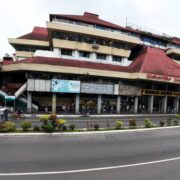‘Unli rice’ and why it remains the center of every Filipino meal

Philippine cuisine offers a vast array of delectable dishes, from the flaming Bikol Express to the sweet but savory adobo and the mouth-watering kare-kare served with a side of bagoong (fermented shrimp paste) for that perfect salty contrast. Filipinos’ understanding of food and their depth of taste reflects their culture like no other.
Every dish is a masterpiece. Its strong aromas and rich flavors leave a lifelong impression once you take a bite, which you are willing to revisit again and again. Still, despite the impressive variety, one ingredient seems to hold it all together: it’s not the meat, sauces, or spices.
Every Filipino knows that no meal is complete without rice. Rice is more than just a grain; it is at the center of every meal—the staple food of every Filipino.
Rice has become a lifestyle. Studies show that the average Filipino eats three times daily for breakfast, lunch, and dinner. According to a report, 80 percent of the population depends on rice as their staple (Vanzi, 2023).
Because of the abundant natural resources, the country is heavily reliant on the agricultural sector, which is a major contributor to the gross domestic product (GDP) and is referred to as the “backbone” of the Philippine economy (Senate of the Philippines, n.d.). In 2022, the share of agriculture in the Philippines’ GDP was 9.55 percent, while the industry contributed approximately 29.23 percent, and the services sector contributed about 61.22 percent (Statista, 2023).
Despite its crucial role in the progression of the economy, the agricultural sector continues to face numerous challenges including climate change impacts and insufficient government support. These affect the productivity and sustainability of farming, which results in higher prices in the market and influences its availability.
Based on the Philippine Statistics Authority, at the national level, a kilogram of special rice had an average retail price of P63.64 during the second phase of August 2024.
The rising price of rice not only impacts Filipino households but also poses a conflicting obstacle for farmers. To meet the demands, the country resorts to rice importation despite being the eighth-largest rice producer in the world, accounting for 2.8 percent of global rice production.
The Philippines is projected to remain the number one global rice importer—taking a record 3.8 million tons—in 2024. This limits rice production in the country and threatens food security, gradually deteriorating the self-sufficiency of the national rice supply.
Amidst these threatening economic and logistical challenges, the concept of unlimited rice, most commonly known as “unli rice,” remains to be a beloved feature of Filipino dining culture. Although many would consider the concept solely to be a marketing gimmick, it brings the beauty of the culture to the world.
It embodies the Filipino spirit of sharing and the warm hospitality that is central to their traditions. Thus, we can see the growing irony that while rice is ingrained in the daily lives of the people, the struggle of rice production and pricing persists, which may continue for a longer period.
As we fight for more practical, effective, and sustainable solutions for the betterment of our society, let us also not forget to appreciate the unwavering dedication and hard work of many for every scoop of rice placed upon our tables. It reflects the efforts of our beloved Filipino farmers, whose hands plant the seeds and help them grow.
This can serve as a powerful reminder that even the simplest gestures, like a scoop of rice served with kindness, can create lasting connections and bring about profound joy.
In this fast-paced world full of uncertainties, let us not forget the taste of our own home and how we are as Filipinos.
It’s not just about unli rice; it’s about how we can also have unli hope, unli dedication, and unli love, even in the darkest of times.
CHRISTLYLE BARRERA VINGSON

















